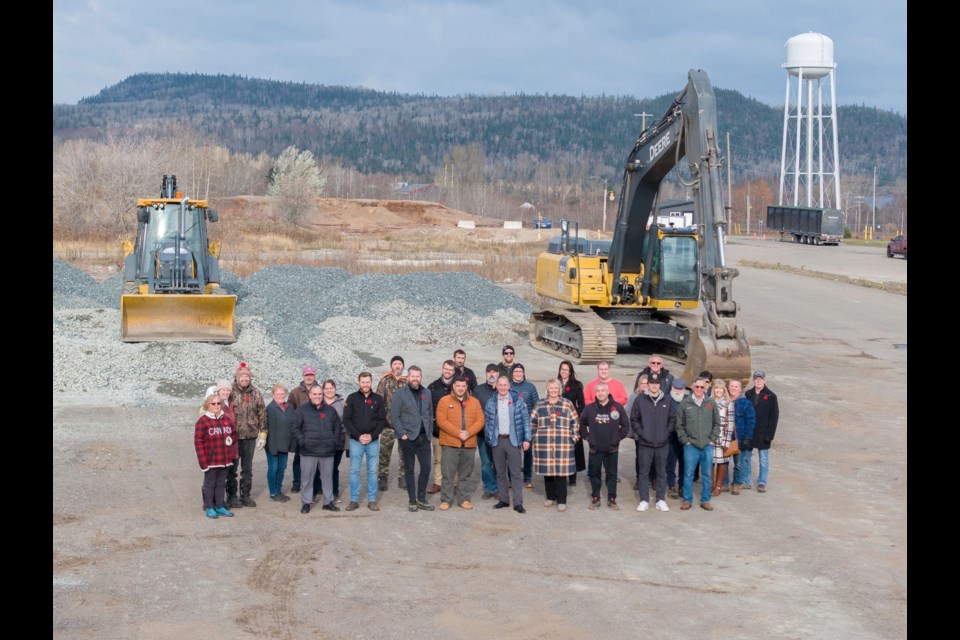Rock Tech Lithium is eyeing the site of the former Norampac Paper mill site in Red Rock as a potential site for a lithium refinery.
The future mine developer and processor has signed a memorandum of understanding (MOU) with the brownfield property owners, BMI Group, and its partners, the Red Rock Indian Band to conduct an assessment for a 50-acre development footprint.
In a joint news release from all three parties, Rock Tech said Red Rock is the closest site to its Georgia Lake lithium mine project, located an hour’s drive north of the community on Lake Superior’s north shore. The mining company has been searching for a site to build a lithium conversion facility in Ontario.
The MOU was signed Nov. 3 with Red Rock Mayor Darquise Robinson in attendance along with residents and various business parties.
André M. Mandel, Rock Tech’s vice president of marketing and communications, cautioned that the MOU is “not the decision of Rock Tech on a definite location.
“The BMI Group and the Red Rock Indian Band have agreed on further exploring all the criteria for two different options - one is transloading facility, the other one is the lithium converter.
“Both could be realized separately on different locations, although there are strong advantages when it comes to transportation.”
Norampac, a subsidiary of cardboard and packaging giant Cascades Canada, shuttered operations in 2006, putting 300 out of work.
The main mill production buildings have been demolished. The current property owners, BMI Group, a venture development company led by Paul, Justus and John Veldman, have been making efforts in the last year to restore the community’s confidence in their vision for the property.
BMI, once known as Riversedge Developments, acquired the brownfield property in 2014.
The company has restored power to the property, set about cleaning up environmental legacy issues, and floated ideas to the community on how to repurpose the site for industrial, commercial and retail use.
For RockTech, the company said the site has the required critical infrastructure with nearby rail and power connections to develop an “intermodal transloading facility" catering to a refinery.
Should it become a reality, a revived Red Rock harbour would be the only commercial port on the north shore of Lake Superior between Sault Ste. Marie and Thunder Bay.
"This partnership truly embodies what we believe is vital: diligent assessment, local and Indigenous community engagement, and strong networks,” Rock Tech CEO Dirk Harbecke in a statement.
“This is not just a refinery, it is about developing a new industry, ensuring chemical supply, green energy, off-take of battery-grade lithium, and zero-waste management. We have invested over 350,000 engineering hours, completed the front-end engineering and design, and established the necessary industrial and procurement network through our existing Guben Converter project. These efforts lay the groundwork for a shovel-ready opportunity for Ontario. To realize the potential of it, we need strong and capable partners."
Paul Veldman, a managing partner with BMI, said this possible development falls within his company’s wheelhouse..
“By combining our industrial development and infrastructure experience, most notably from our Niagara Ports project, with Rock Tech's technical expertise, we are fully supporting the exploration of a viable pathway for lithium processing and intermodal transport in Red Rock and the Province as a whole.
“The mill was shuttered in 2006, and with it, about 300 jobs. This collaboration represents a significant step towards not only meeting the demand for critical battery components but also bringing back some of those jobs.
For Red Rock Indian Band Chief Marcus Hardy, the MOU keeps them on a progressive pro-development path.
"We have the capacity, our people have the capability, and we want to make them shine. We want to give people a good life." Said Red Rock Indian Band Chief Marcus Hardy. "Refine where you mine" is not just a motto for us; it's an opportunity to create new jobs that contribute to the future of the mining industry. Coupled with the development of the northernmost port on the Great Lakes and its ability to take transport pressure off our Northern highways, you have a win-win opportunity worth investing in."




